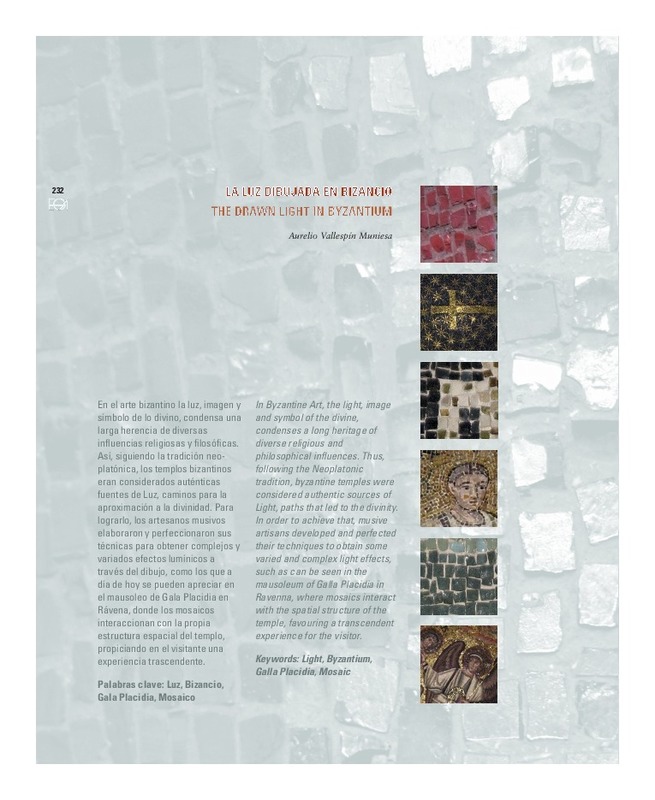JavaScript is disabled for your browser. Some features of this site may not work without it.
Buscar en RiuNet
Listar
Mi cuenta
Estadísticas
Ayuda RiuNet
Admin. UPV
LA LUZ DIBUJADA EN BIZANCIO
Mostrar el registro sencillo del ítem
Ficheros en el ítem
| dc.contributor.author | Vallespín Muniesa, Aurelio
|
es_ES |
| dc.date.accessioned | 2013-01-25T13:50:11Z | |
| dc.date.available | 2013-07-01T22:30:45Z | |
| dc.date.issued | 2012-06-30 | |
| dc.identifier.issn | 1133-6137 | |
| dc.identifier.uri | http://hdl.handle.net/10251/19062 | |
| dc.description.abstract | [EN] In Byzantine Art, the light, image and symbol of the divine, condenses a long heritage of diverse religious and philosophical influences. Thus, following the Neoplatonic tradition, byzantine temples were considered authentic sources of Light, paths that led to the divinity. In order to achieve that, musive artisans developed and perfected their techniques to obtain some varied and complex light effects, such as can be seen in the mausoleum of Galla Placidia in Ravenna, where mosaics interact with the spatial structure of the temple, favouring a transcendent experience for the visitor. | es_ES |
| dc.description.abstract | [ES] En el arte bizantino la luz, imagen y símbolo de lo divino, condensa una larga herencia de diversas influencias religiosas y filosóficas. Así, siguiendo la tradición neoplatónica, los templos bizantinos eran considerados auténticas fuentes de Luz, caminos para la aproximación a la divinidad. Para lograrlo, los artesanos musivos elaboraron y perfeccionaron sus técnicas para obtener complejos y variados efectos lumínicos a través del dibujo, como los que a día de hoy se pueden apreciar en el mausoleo de Gala Placidia en Rávena, donde los mosaicos interaccionan con la propia estructura espacial del templo, propiciando en el visitante una experiencia trascendente. | es_ES |
| dc.language | Español | es_ES |
| dc.language | Inglés | |
| dc.publisher | Editorial Universitat Politècnica de València | es_ES |
| dc.relation.ispartof | EGA. Revista de Expresión Gráfica Arquitectónica | |
| dc.rights | Reserva de todos los derechos | es_ES |
| dc.subject | Luz | es_ES |
| dc.subject | Bizancio | es_ES |
| dc.subject | Gala placidia | es_ES |
| dc.subject | Mosaico | es_ES |
| dc.subject | Light | es_ES |
| dc.subject | Byzantium | es_ES |
| dc.subject | Galla placidia | es_ES |
| dc.subject | Mosaic | es_ES |
| dc.title | LA LUZ DIBUJADA EN BIZANCIO | es_ES |
| dc.title.alternative | THE DRAWN LIGHT IN BYZANTIUM | es_ES |
| dc.type | Artículo | es_ES |
| dc.date.updated | 2013-01-25T10:49:10Z | |
| dc.identifier.doi | 10.4995/ega.2012.1375 | |
| dc.rights.accessRights | Abierto | es_ES |
| dc.description.bibliographicCitation | Vallespín Muniesa, A. (2012). LA LUZ DIBUJADA EN BIZANCIO. EGA. Revista de Expresión Gráfica Arquitectónica. 17(19):232-241. https://doi.org/10.4995/ega.2012.1375 | es_ES |
| dc.description.accrualMethod | SWORD | es_ES |
| dc.relation.publisherversion | https://doi.org/10.4995/ega.2012.1375 | es_ES |
| dc.description.upvformatpinicio | 232 | |
| dc.description.upvformatpfin | 241 | |
| dc.description.volume | 17 | |
| dc.description.issue | 19 | |
| dc.identifier.eissn | 2254-6103 | |
| dc.description.references | Gilles Deleuze, 2008 (1981). Pintura. El concepto de diagrama. Buenos Aires: Cactus. | es_ES |
| dc.description.references | John Beckwith, 2010 (1970). Arte paleocristiano y bizantino. Madrid: Cátedra. | es_ES |
| dc.description.references | John Gage, 2001 (1993). Color y cultura. Madrid: Siruela. | es_ES |
| dc.description.references | Pseudo-Dionisio Aeropagita, 2007. Obras completas. Madrid: B.A.C. | es_ES |








